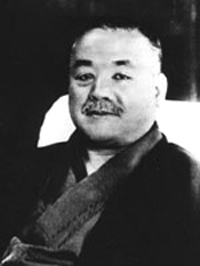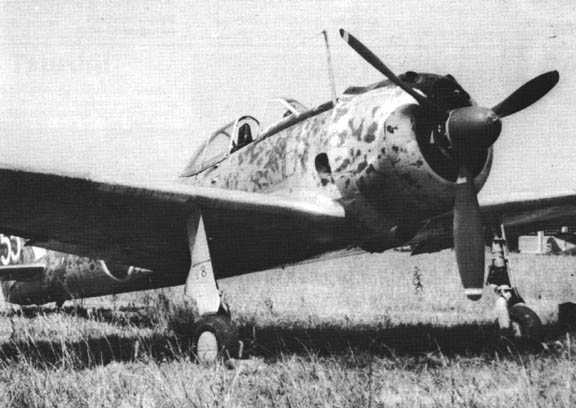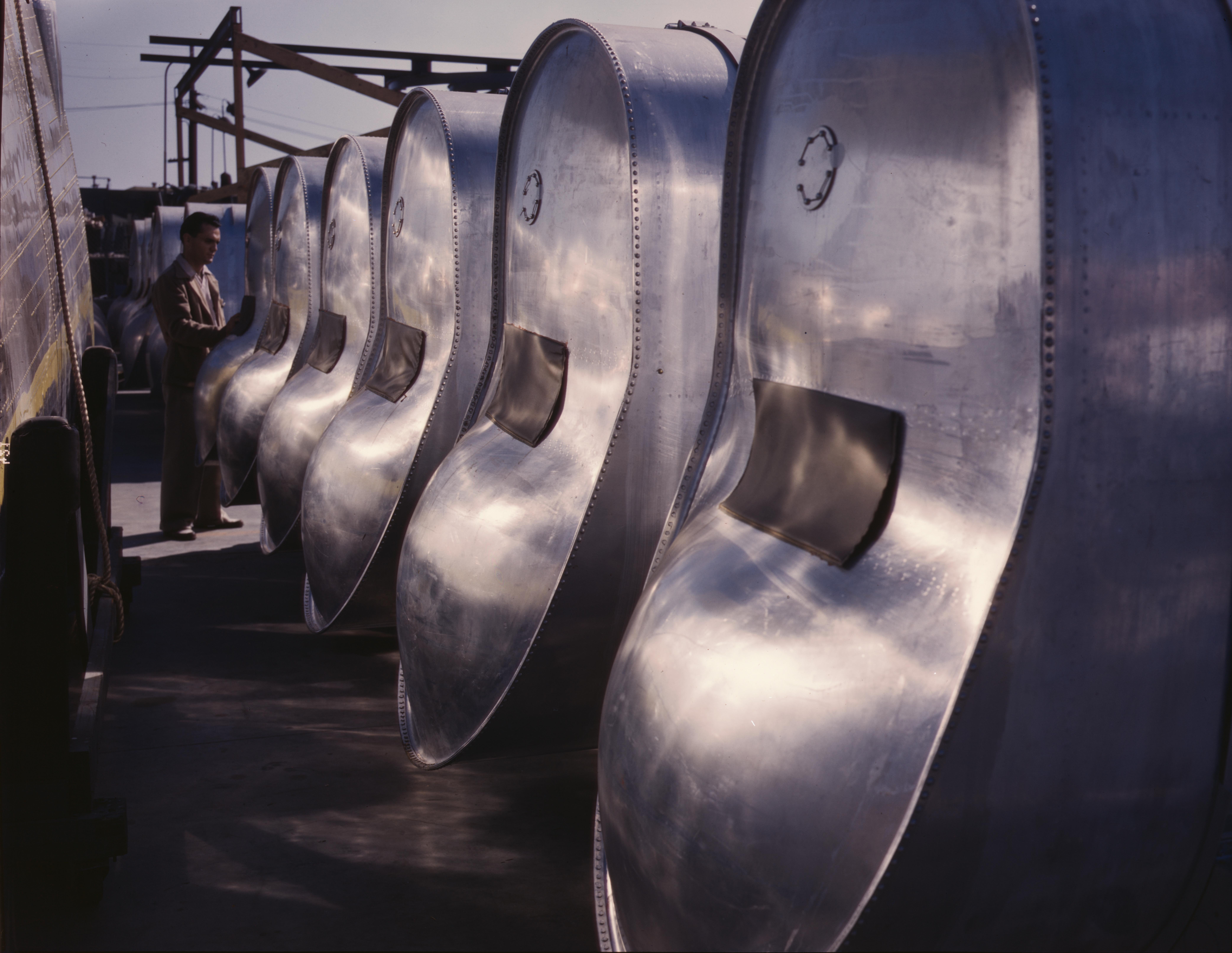|
Ki-84
The is a single-seat fighter flown by the Imperial Japanese Army Air Service in the last two years of World War II. The Allied reporting name was "Frank"; the Japanese Army designation was . The Ki-84 is generally considered the best Japanese fighter to operate in large numbers during the conflict. The aircraft boasted high speed and excellent maneuverability with an armament (up to two 30 mm and two 20 mm cannon) that gave it formidable firepower. The Ki-84's performance matched that of any single-engine Allied fighter it faced, and its operational ceiling enabled it to intercept high-flying B-29 Superfortress bombers. Pilots and crews in the field learned to take care with the plane's high-maintenance Nakajima Homare engine and a landing gear prone to buckling. The difficulties of Japan's situation late in the war took a toll on the aircraft's field performance as manufacturing defects multiplied, good quality fuel proved difficult to procure, and experienced pilots gr ... [...More Info...] [...Related Items...] OR: [Wikipedia] [Google] [Baidu] |
Nakajima Ki-116
The Nakajima Ki-116 was a late-World War II aircraft developed for the Imperial Japanese Army Air Force. It was essentially a Ki-84 ''Hayate'' with the Nakajima Ha-45 engine replaced with a Mitsubishi Ha-112. The design was handled by Mansyū Aircraft in Manchukuo, and thus it is often designated Mansyū Ki-116. Design and development The Ki-116 was the last variant of the Nakajima Ki-84 ''Hayate'' to enter flight trials. It was originally the fourth Mansyu-built Ki-84-I, adapted to take a Mitsubishi Ha-112-II (aka Kinsei 62) engine, the same engine used in the Kawasaki Ki-100, driving a three-blade propeller borrowed from a Mitsubishi Ki-46-III ''Dinah''. This conversion proved to be very successful, a reduction of in empty weight being registered. The aircraft was still undergoing tests at the time of Japan's defeat. It appeared somewhat longer and had an increased tail surface area compared to the original Ki-84. This aircraft was created as a fighter-interceptor. ... [...More Info...] [...Related Items...] OR: [Wikipedia] [Google] [Baidu] |
Nakajima Aircraft Company
The was a prominent Japanese aircraft manufacturer and aviation engine manufacturer throughout World War II. It continues as the car and aircraft manufacturer Subaru. History The Nakajima Aircraft company was Japan's first aircraft manufacturer, and was founded in 1918 by Chikuhei Nakajima, a naval engineer, and Seibei Kawanishi, a textile manufacturer, as . In 1919, the two founders split and Nakajima bought out Nihon Aircraft's factory with tacit help from the Imperial Japanese Army. The company was renamed Nakajima Aircraft Company in 1919. The company's manufacturing facilities consisted of the following: * Tokyo plant * Musashino plant * Donryu plant * Ota plant, near Ōta Station. Visited by Emperor Shōwa on November 16, 1934. Critically damaged by American bombardment on February 10, 1945. Currently a Subaru Corporation plant for kei trucks. * Koizumi plant, near Nishi-Koizumi station. Critically damaged by American bombardment on April 3, 1945. Currently a Sanyo pla ... [...More Info...] [...Related Items...] OR: [Wikipedia] [Google] [Baidu] |
Nakajima Ki-43
The Nakajima Ki-43 ''Hayabusa'' (, "Peregrine falcon", "Army Type 1 Fighter" ) is a single-engine land-based tactical fighter used by the Imperial Japanese Army Air Service in World War II. The Allied reporting name was "Oscar", but it was often called the "Army Zero" by American pilots because it bore a certain resemblance to the Mitsubishi A6M Zero, the Imperial Japanese Navy's counterpart to the Ki-43. Both aircraft had generally similar layout and lines, and also used essentially the same Nakajima Sakae radial engine, with similar round cowlings and bubble-type canopies (the ''Oscar'''s being distinctly smaller and having much less framing than the A6M). While relatively easy for a trained eye to tell apart with the "finer" lines of the Ki-43's fuselage – especially towards the tail – and more tapered wing planform; in the heat of battle, given the brief glimpses and distraction of combat, Allied aviators frequently made mistakes in enemy aircraft identification in th ... [...More Info...] [...Related Items...] OR: [Wikipedia] [Google] [Baidu] |
Nakajima Homare
The Nakajima Homare (誉, "praise" or, more usually, "honour") was an air-cooled twin-row 18 cylinder radial Japanese aircraft engine manufactured during World War II. Producing almost 2,000 horsepower, it was used widely by both the Imperial Japanese Army and the Imperial Japanese Navy. Given the Navy service designation NK9, the "Homare" was also given the company designation NBA, Army experimental designation Ha-45 (ハ45) or, Army long designation Nakajima Army Type 4 1,900 hp Air-Cooled Radial and, (coincidentally) unified designation code of Ha-45.Gunston 1989, p.105. Design and development Development of the Homare started in 1940, and certification was completed in 1941. It succeeded Nakajima's previous 14 cylinder Sakae (Ha-25) engine, which had its own forward seven cylinders staggered from the rear seven for efficient cooling. The design was exceptionally compact, with an external diameter of 118 cm, a mere 3 cm larger than the Sakae. With a bore and ... [...More Info...] [...Related Items...] OR: [Wikipedia] [Google] [Baidu] |
World War II Allied Names For Japanese Aircraft
The World War II Allied names for Japanese aircraft were reporting names, often described as codenames, given by Allied personnel to Imperial Japanese aircraft during the Pacific campaign of World War II. The names were used by Allied personnel to identify aircraft operated by the Japanese for reporting and descriptive purposes. Generally, Western men's names were given to fighter aircraft, women's names to bombers, transports, and reconnaissance aircraft, bird names to gliders, and tree names to trainer aircraft. The use of the names, from their origin in mid-1942, became widespread among Allied forces from early 1943 until the end of the war in 1945. Many subsequent Western histories of the war have continued to use the names. History During the first year of the Pacific War beginning on 7 December 1941, Allied personnel often struggled to quickly, succinctly, and accurately identify Japanese aircraft encountered in combat. They found the Japanese designation system bewilder ... [...More Info...] [...Related Items...] OR: [Wikipedia] [Google] [Baidu] |
Fighter Aircraft
Fighter aircraft are fixed-wing military aircraft designed primarily for air-to-air combat. In military conflict, the role of fighter aircraft is to establish air superiority of the battlespace. Domination of the airspace above a battlefield permits bombers and attack aircraft to engage in tactical and strategic bombing of enemy targets. The key performance features of a fighter include not only its firepower but also its high speed and maneuverability relative to the target aircraft. The success or failure of a combatant's efforts to gain air superiority hinges on several factors including the skill of its pilots, the tactical soundness of its doctrine for deploying its fighters, and the numbers and performance of those fighters. Many modern fighter aircraft also have secondary capabilities such as ground attack and some types, such as fighter-bombers, are designed from the outset for dual roles. Other fighter designs are highly specialized while still filling the ma ... [...More Info...] [...Related Items...] OR: [Wikipedia] [Google] [Baidu] |
Imperial Japanese Army Air Force
The Imperial Japanese Army Air Service (IJAAS) or Imperial Japanese Army Air Force (IJAAF; ja, 大日本帝國陸軍航空部隊, Dainippon Teikoku Rikugun Kōkūbutai, lit=Greater Japan Empire Army Air Corps) was the aviation force of the Imperial Japanese Army (IJA). Just as the IJA in general was modeled mainly on the German Army, the IJAAS initially developed along similar lines to the Imperial German Army Aviation; its primary mission was to provide tactical close air support for ground forces, as well as a limited air interdiction capability. The IJAAS also provided aerial reconnaissance to other branches of the IJA. While the IJAAS engaged in strategic bombing of cities such as Shanghai, Nanking, Canton, Chongqing, Rangoon, and Mandalay, this was not the primary mission of the IJAAS, and it lacked a heavy bomber force. It did not usually control artillery spotter/observer aircraft; artillery battalions controlled the light aircraft and balloons that operated in these ... [...More Info...] [...Related Items...] OR: [Wikipedia] [Google] [Baidu] |
Imperial Japanese Army Air Service
The Imperial Japanese Army Air Service (IJAAS) or Imperial Japanese Army Air Force (IJAAF; ja, 大日本帝國陸軍航空部隊, Dainippon Teikoku Rikugun Kōkūbutai, lit=Greater Japan Empire Army Air Corps) was the aviation force of the Imperial Japanese Army (IJA). Just as the IJA in general was modeled mainly on the German Army, the IJAAS initially developed along similar lines to the Imperial German Army Aviation; its primary mission was to provide tactical close air support for ground forces, as well as a limited air interdiction capability. The IJAAS also provided aerial reconnaissance to other branches of the IJA. While the IJAAS engaged in strategic bombing of cities such as Shanghai, Nanking, Canton, Chongqing, Rangoon, and Mandalay, this was not the primary mission of the IJAAS, and it lacked a heavy bomber force. It did not usually control artillery spotter/observer aircraft; artillery battalions controlled the light aircraft and balloons that operated in the ... [...More Info...] [...Related Items...] OR: [Wikipedia] [Google] [Baidu] |
Lieutenant
A lieutenant ( , ; abbreviated Lt., Lt, LT, Lieut and similar) is a commissioned officer rank in the armed forces of many nations. The meaning of lieutenant differs in different militaries (see comparative military ranks), but it is often subdivided into senior (first lieutenant) and junior (second lieutenant and even third lieutenant) ranks. In navies, it is often equivalent to the army rank of captain; it may also indicate a particular post rather than a rank. The rank is also used in fire services, emergency medical services, security services and police forces. Lieutenant may also appear as part of a title used in various other organisations with a codified command structure. It often designates someone who is " second-in-command", and as such, may precede the name of the rank directly above it. For example, a "lieutenant master" is likely to be second-in-command to the "master" in an organisation using both ranks. Political uses include lieutenant governor in various g ... [...More Info...] [...Related Items...] OR: [Wikipedia] [Google] [Baidu] |
Fuel Tank
A fuel tank (also called a petrol tank or gas tank) is a safe container for flammable fluids. Though any storage tank for fuel may be so called, the term is typically applied to part of an engine system in which the fuel is stored and propelled (fuel pump) or released (pressurized gas) into an engine. Fuel tanks range in size and complexity from the small plastic tank of a butane lighter to the multi-chambered cryogenic Space Shuttle external tank. Uses Typically, a fuel tank must allow or provide the following: * Storage of fuel: the system must contain a given quantity of fuel and must avoid leakage and limit evaporative emissions. * Filling: the fuel tank must be filled in a secure way, without sparks. * Provide a method for determining level of fuel in tank, gauging (the remaining quantity of fuel in the tank must be measured or evaluated). * Venting (if over-pressure is not allowed, the fuel vapors must be managed through valves). * Feeding of the engine (throug ... [...More Info...] [...Related Items...] OR: [Wikipedia] [Google] [Baidu] |
Gasoline Direct Injection
Gasoline direct injection (GDI), also known as petrol direct injection (PDI), is a mixture formation system for internal combustion engines that run on gasoline (petrol), where fuel is injected into the combustion chamber. This is distinct from manifold fuel injection systems, which inject fuel into the intake manifold. The use of GDI can help increase engine efficiency and specific power output as well as reduce exhaust emissions. The first GDI engine to reach production was introduced in 1925 for a low-compression truck engine. Several German cars used a Bosch mechanical GDI system in the 1950s, however usage of the technology remained rare until an electronic GDI system was introduced in 1996 by Mitsubishi for mass-produced cars. GDI has seen rapid adoption by the automotive industry in recent years, increasing in the United States from 2.3% of production for model year 2008 vehicles to approximately 50% for model year 2016. Operating principle Charge modes The 'charg ... [...More Info...] [...Related Items...] OR: [Wikipedia] [Google] [Baidu] |
Water Injection (engines)
In internal combustion engines, water injection, also known as anti-detonant injection (ADI), can spray water into the incoming air or fuel-air mixture, or directly into the combustion chamber to cool certain parts of the induction system where "hot points" could produce premature ignition. In jet engines it increases engine thrust at low speeds and at takeoff. Water injection was used historically to increase the power output of military aviation engines for short durations, such as dogfights or takeoff. However it has also been used in motor sports and notably in drag racing. In Otto cycle engines, the cooling effects of water injection also enables greater compression ratios by reducing engine knocking (detonation). Alternatively, this reduction in engine knocking in Otto cycle engines means that some applications gain significant performance when water injection is used in conjunction with a supercharger, turbocharger, or modifications such as aggressive ignition timing. Depend ... [...More Info...] [...Related Items...] OR: [Wikipedia] [Google] [Baidu] |






